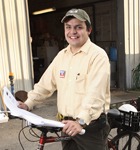In 2007, the University of Richmond’s president, Edward Ayers, signed the Presidents’ Climate Commitment, acknowledging the “unprecedented scale and speed of global warming and its potential for large-scale, adverse health, social, economic and ecological effects.” With Ayers signature, the college pledged to measure its carbon footprint and develop a plan to reach climate neutrality. And just four short years later, sustainability has become a guiding principle at the University of Richmond.
In that time, the university has completed a greenhouse-gas-emissions inventory and has set a goal to reduce its 2010 emissions by 31 percent by 2020. To conserve energy, the school installed steam-trap systems, economizers, energy-management systems, and lighting sensors. And if all that weren’t enough, it also has three committees and three full-time staff members devoted to implementing and coordinating sustainability programs. It’s a university with a mission, and heading up that mission is Dave Merchan.

Having completed a greenhouse-gas-emissions inventory, the University of Richmond aims to reduce its 2010 emissions by 31% by 2020.
Merchan, who worked as an engineer in training from 2000 to 2005 under the direction of university engineer George Souleret, is one of the major contributors to the school’s sustainable vision. After working awhile as an HVAC designer, Merchan developed an interest in green building and became a LEED AP, and in 2008 he returned to Richmond as project engineer for university facilities. He immediately put his new skills to work, helping the school meet the goals of its Climate Action Plan.
The plan is being treated as a living document, and it will be reviewed and revised as the university progresses toward climate neutrality. New technologies, economic conditions, and changes in climate science may necessitate changes to the school’s strategies, but Merchan has high hopes for the plan however it evolves. “I hope it raises awareness about our responsibilities as stewards of this Earth and its resources,” he says. Many college campuses are making sustainability a focus, but few can boast the accomplishments the University of Richmond can. Its Weinstein Hall was the second LEED building in Virginia—admittedly, by only two weeks—and the first in central Virginia, and it was also the first building in central Virginia to offer recharging stations for electric vehicles. And, four more school buildings—the Weinstein Center for Recreation and Wellness, Queally Hall, Robins Stadium, and the Heilman Dining Center—illustrate the school’s sustainable mission in a variety of other ways.

The Weinstein Center for Recreation and Wellness earned LEED Gold certification in February 2011. It’s one of five standout green buildings on campus.
The Weinstein Center was one of only five facilities in the country to receive the 2008 National Intramural Recreational Sports Association’s Outstanding Sports Facility Award, and it earned LEED Gold certification in February 2011. It ended up being one of the most efficient buildings in the state by incorporating native and adaptive plants that do not require a permanent irrigation system, sidewalks and roofing with a high solar-reflective index, low-flow showerheads and toilets and waterless urinals, low-VOC paints, and a high-efficiency HVAC system with carbon-dioxide monitoring that allows the reduction of outside air during unoccupied times. Queally Hall incorporates many of the same features, including power meters that measure and verify energy consumption by the building’s systems. In Robins Stadium, more than 90 percent of the regularly occupied interior spaces have outdoor views. And the Heilman Dining Center? It, too, has obtained LEED certification.
The university has adopted a minimum standard of LEED Silver for all new construction on campus and intends to retrofit existing buildings so they run as efficiently as possible. According to Merchan, the school aims to reduce power consumption in renovation projects by evaluating the reduction in the carbon footprint, the return on investment, the ability to educate and change the behavior of building occupants, and system reliability and longevity. To meet these goals, Merchan relies heavily on his team—and it doesn’t hurt that he sincerely enjoys working with the next generation of LEED APs. “We will have to work as a team in order to meet the goals set by the school’s leaders, and in doing so, we get to prepare the [students of the] community for the challenges they will face outside of the university,” Merchan says. “My favorite part of this job really is working with students and teaching them about green building; they are the future.”

